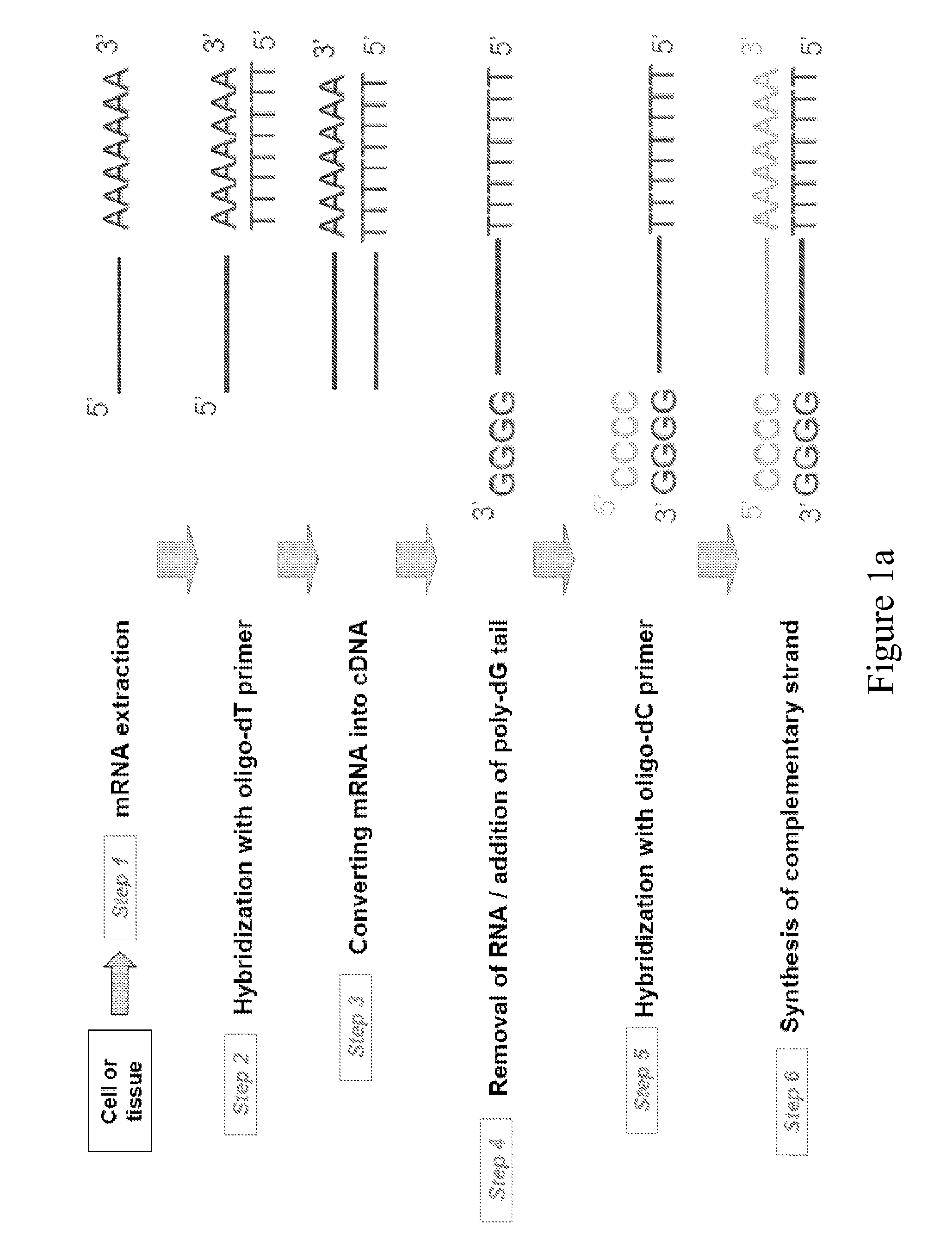Transcription infidelity, detection and uses thereof
a technology applied in the field of transcription infidelity and detection, can solve the problems of rna editing not being able to explain two types of ti events, unresolved issue, and affecting the rate of this phenomenon
- Summary
- Abstract
- Description
- Claims
- Application Information
AI Technical Summary
Benefits of technology
Problems solved by technology
Method used
Image
Examples
example 1
Principle of Typical cDNA Library Construction and Sequencing (see FIG. 1)
[0169]The first step in preparing a complementary DNA (cDNA) library is to isolate the mature mRNA from the cell or tissue type of interest. Because of their poly(A) tail, it is straightforward to obtain a mixture of all cell mRNA by hybridization with complementary oligo dT linked covalently to a matrix. The bound mRNA is then eluted with a low salt buffer. The poly(A) tail of mRNA is then allowed to hybridize with oligo dT in the presence of a reverse transcriptase, an enzyme that synthesizes a complementary DNA strand from the mRNA template. This yields double strand nucleotides containing the original mRNA template and its complementary DNA sequence. Single strand DNA is next obtained by removing the RNA strand by alkali treatment or by the action of RNase H. A series of dG is then added to the 3′ end of single strand DNA by the action of an enzyme called terminal transferase, a DNA polymerase that does no...
example 2
[0170]EST databases contain sequence information that correspond to the cDNA sequence obtained from cDNA libraries and therefore correspond essentially to the sequence of individual mRNA present at any given time in the tissue that was used to produce these libraries. The quality of these sequences has been called into question for several reasons. First, as discussed above, the process of producing cDNA libraries initially relied heavily on the presence of a poly(A) tail at the 3′ end of eukaryotic mRNA. Second, mRNA are quite fragile molecules that are easily digested by high abundance nucleases called RNases. Third, while building and sequencing these libraries, little attention was paid to the quality of the original material used and its storage. Because of this, EST sequences have been used to annotate genomic information i.e., to determine whether an identified and fully sequenced segment of genomic DNA encodes any specific mRNA. In this context, EST sequen...
example 3
Identification of Sequence Variations Between ESTs from Normal and Cancer Origins
[0192]17 genes are selected on the basis of their large representation in the database. Each EST sequence was then aligned against its curated mRNA reference sequence (RefSeq) from NCBI using the MegaBLAST. This creates a matrix in which any given base is defined by the number of ESTs matching to this position. We then measured the proportion of ESTs deviating from RefSeq at any given position. Comparison of aligned EST sequences according to the tissue origin led us to identify sequence variations occurring at each base position in either the cancer or the normal group. FIG. 4 provides a graphical representation of these variations occurring in the normal and cancer sets for the 17 selected genes. Visual examination of the data revealed that sequence variation occurred most frequently in the cancer set, and further that the phenomenon appeared most predominant in specific mRNA sites. The majority of th...
PUM
| Property | Measurement | Unit |
|---|---|---|
| cell surface protein | aaaaa | aaaaa |
| plasma | aaaaa | aaaaa |
| heterogeneity | aaaaa | aaaaa |
Abstract
Description
Claims
Application Information
 Login to View More
Login to View More - R&D
- Intellectual Property
- Life Sciences
- Materials
- Tech Scout
- Unparalleled Data Quality
- Higher Quality Content
- 60% Fewer Hallucinations
Browse by: Latest US Patents, China's latest patents, Technical Efficacy Thesaurus, Application Domain, Technology Topic, Popular Technical Reports.
© 2025 PatSnap. All rights reserved.Legal|Privacy policy|Modern Slavery Act Transparency Statement|Sitemap|About US| Contact US: help@patsnap.com



